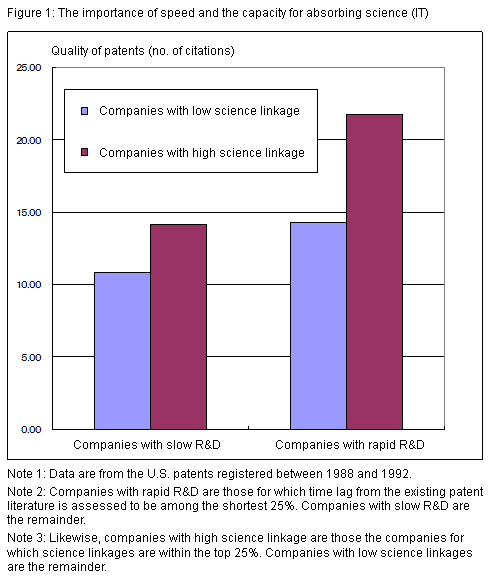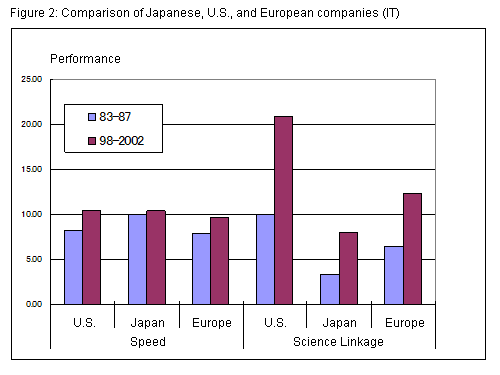Introduction
R&D productivity may be defined as the efficiency with which research and development brings forth new and useful knowledge. This productivity is extremely important to the economic growth of a country like Japan that is close to the technological frontier in many fields. According to endogenous growth theory, the most important factor for determining the economic growth rate is the rate of advance of a country's use of knowledge stock, and its important determinant is the R&D productivity.
So what are the determinants of the corporate R&D productivity? Empirical research into this question is currently being carried out actively from various angles, partly as a result of the recent accessibility of bibliometric data on patents via electronic media. I will present here part of my own research into the effects of speed and the capacity for absorbing scientific knowledge, which may both be considered two of the most basic determinants for the R&D performance at the corporate level (Nagaoka; 2006, 2007).
High-speed corporate R&D enables a firm to obtain high-quality patents
In many cases, the advantage of being the first mover in R&D is more important than in production or sales. R&D is the most upstream point of any business, so being the first mover in R&D helps a firm obtain the first-mover advantage in downstream business activities too. In addition, since a patent right provides an exclusive right, the first company to come up with a particular patentable invention is the only one able to use it. The rule that only the first person to make a discovery can acquire the rights to it - known as the "priority rule" - is the most fundamental rule governing competition in knowledge production, which includes that in the scientific world.
One would thus expect that, in R&D for which speed is important, being the first mover would enlarge the scope of rights that a company is able to secure for its patent. This is actually the case, as can be seen in Figure 1: the high speed of corporate R&D is important for acquiring high-quality patents. This figure shows the relationship between the speed of R&D and the quality of patents (assessed in terms of the number of forward citations) in the information technology sector, and is based on the data from a corporate database of some 1,200 companies worldwide that have United States patents in the area of information technology. These companies were all taken from among major world companies that have a large number of U.S. patents. The speed of R&D is measured here in terms of the average length of the time lag between the company's patents and their prior patent literature; it is the median of the lag between when each of the company's patents was registered and when the U.S. patents cited by those patents were registered. For both companies with high science linkage and low science linkage (which will be discussed later), the companies for which R&D speed ranks within the top 25% have the patents with an average of approximately 30%-50% more citations than those of the other companies.

The capacity for absorbing science substantially enhances corporate R&D performance
The ability to exploit scientific knowledge for technological improvement and innovation is also an important determinant of the corporate R&D productivity. Scientific advances do not bring about technological advances in a unidirectional fashion; there are cases in which basic research driven by the needs for actual practical applications led to both good basic research and good technology. Nonetheless, the ability to make practical use of scientific strength is believed to have a large effect on the performance of corporate R&D.
Figure 1 uses the frequency with which an invention cites scientific papers as its prior literature ("science linkage"); companies the capacity of which for absorbing science is high and those in which it is low are separated and their respective performances compared. It can be seen that for both the high and the low R&D speed groups, the quality of patents of the companies in which science linkages are within the top 25% is on average approximately 30%-50% higher than those of the rest of the companies. For the companies in the top 25% in terms of both speed and science linkage (comprising approximately 5% of the total number of companies), the quality of their patents is double that of the companies in the lower 75% in terms of both speed and science linkage (55% of all the companies).
The characteristics of Japanese companies
Finally, let us compare recent performance of Japanese companies and the companies from the U.S. and Europe on the two indicators of speed and the capacity for absorbing science. In Figure 2 below, Japanese companies had the fastest R&D speed in 1983-1987, which is taken to be 10.0; this is compared with the R&D speed of Japanese companies in 1998-2002 and the speed of U.S. and European companies in those same periods. The U.S. companies had the highest level of science linkage in 1983-1987, which is taken to be 10.0. Comparisons are made in the same way.
As Figure 2 shows, the R&D speed of U.S. and European companies has increased considerably, and the difference between U.S. and European companies on the one hand and Japanese companies on the other has recently almost disappeared. At the same time, the science linkage of U.S. companies has shown a rapid increase, and the difference between U.S. and Japanese companies has widened.

Conclusion
The sphere of R&D is intensely competitive. Around the world many companies are entering into business and competing over research results. There is strong evidence for which the companies with rapid R&D and the companies that apply extensively the results of scientific advances to their own R&D results (inventions) acquire better quality patents. When measured by this yardstick, the performance of Japanese companies is not becoming poorer in absolute terms, but given the remarkable improvements of performance of U.S. companies their relative position has worsened in recent years.
What are the determinants of these changes in corporate performance and the regional difference? The roles of new entrants, competition, structural changes on the demand side, university-industry collaboration mechanism, the patent system, etc., are all potential factors. Identifying the role of each potential factor should be an important topic for future research.


